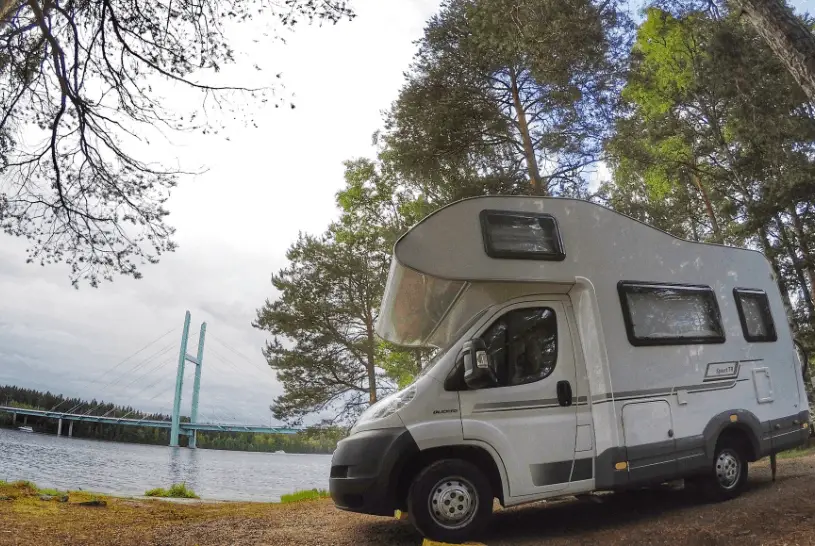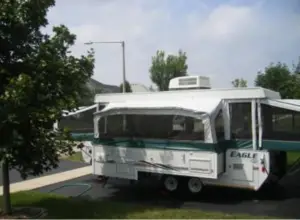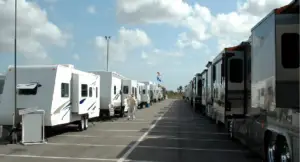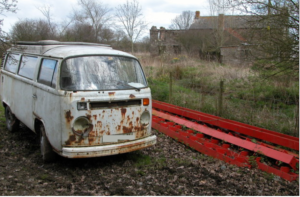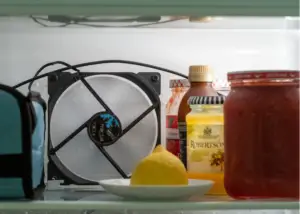RVs or motorhomes are almost like homes on wheels. You get all the basic utilities needed for day to day life. So, how does the whole system works? Its pretty easy to live in an RV if you have figured the basic things. Most things like power, sewage can be handled at the campsite. And what about water, do you get it at the campsite? Lets find out,
RV water Sources – how does it work
Broadly, there are 2 different systems that are used for this purpose: a fresh water tank system and city water hookup system.
Most of the vans manufactured these days have the fresh water tanks, with a sizable water capacity (usual capacity between 30-60 gallons).
In RV fresh water tanks, you are required to manually insert water. Newer RVs have a clear indication of where to insert water, while older ones have a fill-up area hole just like diesel in their outside compartment.
This system is so common that most reputed gas stations offer you a free water refill with your gas or diesel purchase. These fill-up spots are also present in many public areas: mostly parks, campgrounds and even well-known retailers like Walmart.
If none of this rings your bells, you can simply buy portable water jugs and pour them in the tank. This is the portable water that goes with you as you travel in the vehicle.
Heated Water requirements
The water heater takes water from the fresh water tank and heats it up, so most RVs have both a hot shower and a cold shower option.
In this system, the water is stored in the tank, and at lower levels, it cannot, naturally, reach the faucets of the vehicle. As a result, water pumps have to be installed to make sure that water is pumped from the tank into the taps. These water pumps are battery powered, and usually have a filter between the pumps and the tank, to ensure that no impurities are pumped into the faucets.
Water pumps are, after-all, machinery that is subject to wear and tear and can break down from time to time. In case the pump does not work properly, the first approach should be to check if there is an issue with the wiring.
The hose can be checked to ensure that the pump is actually picking up water – if it is not warm then there is a possible leakage between the hose and the tank. If the hose is fine, there could be a leak at another place. You should probably not mess with the internal wiring. Instead, prefer getting the vehicle checked by a professional to ensure that the evil is nipped in the bud.
RVs are specially designed to conserve the freshwater allowing for the tank to last longer – constantly water changing can ruin the recreational factor of the recreational vehicle. The toilets in the RV are specially built to use less water at each flush.
Dealing With Tank Smells
Sometimes, the fresh water tank can become smelly if the water is held in there for a very long time. In that case, the water must be completely changed and the tank bleached.
This is possible by adding the bleach to the tank just like water is added, and then remove all water through the faucets: both hot and cold. Once the water is removed, refill the tank and remove it again. You may use supplied water for this purpose.
After removing the bleach completely, the tank can be refilled, now completely usable. Another issue can be the sanitization of water, for which it is recommended that the fresh-water tank should be filled only with purified fresh water. This can help prevent bacteria buildup in the tank.
The second method basically has a technical difference. In fresh water method, the water is poured into the tank through an intermediary medium that takes the paper from the actual source that would have been used to extract it and pours it into the system.
The second method focuses on getting water directly from a tap or faucet that is providing supplied water: a hose is needed. There is no tang involved here: it is a direct connection from an outside source to the faucet inside your vehicle, thus, this method is not portable.
City Water Connection
The City Water Connection, as it is called, has the benefit of a continuous supply of water with better pressure than tanked water. However, consideration has to make that water pressure can be too high for the plumbing work of the vehicle to withhold.
This is particularly true for older vehicles, where the plumbing lines are thin and can burst due to higher pressure – you don’t want a fountain in your vehicle, do you? Installing a water regulation filter can help normalize the pressure.
Another important consideration here is the suggested use of filter in this water system: supplied water, unlike freshwater, can have mercury and other harmful contents that can have adverse effects upon drinking.
RVs can, therefore, be considered like a small, compact apartment in terms of the plumbing work, with its own water tank, and direct water supply (if needed), which is pumped to various outlets of water throughout the vehicle.
As a result, it is important to understand that the plumbing requires maintenance and can actually break down. The water system is highly dependent on the plumbing to work properly. This can be ensured by regularly checking the plumbing and if any leaks or minor issues are spotted they should be corrected immediately. A plumber can be consulted if things are too complicated.

